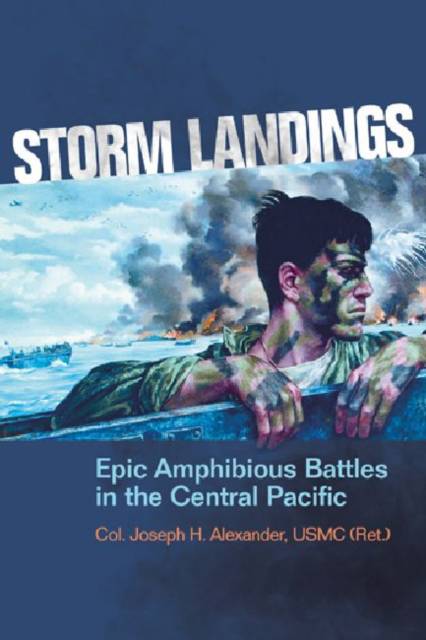
- Afhalen na 1 uur in een winkel met voorraad
- Gratis thuislevering in België vanaf € 30
- Ruim aanbod met 7 miljoen producten
- Afhalen na 1 uur in een winkel met voorraad
- Gratis thuislevering in België vanaf € 30
- Ruim aanbod met 7 miljoen producten
Zoeken
Storm Landings
Epic Amphibious Battles in the Central Pacific
Estate Of Joseph H Alexander
Paperback | Engels
€ 36,45
+ 72 punten
Omschrijving
The Pacific War changed abruptly in November 1943 when Admiral Chester Nimitz unleashed a relentless 18-month, 4,000-mile offensive across the Central Pacific, spearheaded by fast carrier task forces and U.S. Marine and Army assault troops. The sudden American proclivity for amphibious frontal assaults against fortified islands astonished Japanese commanders, who called them "storm landings" because they differed so sharply from the limited landings of 1942-43. This is the story of seven epic assaults from the sea against murderous enemy fire-Tarawa, Saipan, Guam, Tinian, Peleliu, Iwo Jima, and Okinawa. Each risky battle enhanced the U.S. capability to concentrate overwhelming naval force against a distant island and literally kick down the front door. While the assault forces learned priceless operational lessons from each landing, so did the Japanese. The ultimate U.S. victory in the seven "storm landings" came at the total cost of 100,000 killed and wounded. The survivors faced the prospect of even bloodier future beachheads against mainland Japan. Award-winning historian Joseph Alexander relates this extraordinary story with an easy narrative style bolstered by years of analyzing U.S. and Japanese battle accounts, personal interviews with veterans, and his own amphibious warfare experience. Abounding with human-interest stories of colorful "web-footed amphibians," his book vividly portrays the sheer drama of these naval battles whose magnitude and ferocity may never again be seen in this world.
Specificaties
Betrokkenen
- Auteur(s):
- Uitgeverij:
Inhoud
- Aantal bladzijden:
- 264
- Taal:
- Engels
Eigenschappen
- Productcode (EAN):
- 9781591140177
- Verschijningsdatum:
- 15/09/2012
- Uitvoering:
- Paperback
- Formaat:
- Trade paperback (VS)
- Afmetingen:
- 150 mm x 226 mm
- Gewicht:
- 385 g

Alleen bij Standaard Boekhandel
+ 72 punten op je klantenkaart van Standaard Boekhandel
Beoordelingen
We publiceren alleen reviews die voldoen aan de voorwaarden voor reviews. Bekijk onze voorwaarden voor reviews.











